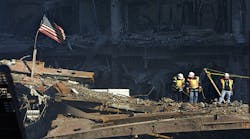As I write this while working from home on Sept. 8, it is a warm, sunny, perfect late-summer day. Almost too warm. Almost too perfect. It’s hard to believe that autumn, followed quickly by winter, will be here before I know it.
On Sept. 11, 2001, my circumstances were different: I was living in a different home, had a different job, was “almost” engaged to a different man, had different dogs… One thing was the same: it was a warm, sunny, perfect late-summer day and I was working from home. Life could not have been sweeter.
And then it happened; first one plane, then another, then another, then another. Both of the World Trade Center towers, the Pentagon, a field in Pennsylvania… What was happening?
It quickly became apparent it was a planned act of terrorism and once the immediate shock and grief wore off, the nation started the painful process of rescue, recovery, cleanup and rebuilding. Here at EHS Today, we covered the stories of the first responders who lost their lives and who tried to save lives, the cleanup workers slowly removing the massive piles of rubble, the government agencies tasked with trying to keep workers safe and monitor the contamination from the tons and tons of asbestos and other hazardous substances unleashed as the buildings disintegrated.
In fact, over the past 15 years, EHS Today has published over 300 articles, five blog entries and two photo galleries related to 9/11.
We revealed that 9/11 first responders had double the risk of asthma (“9/11 Responders Twice as Likely to Have Asthma”), faced higher cancer risks (“Study: WTC Conditions on 9/11 Led to Higher Cancer Risk for Firefighters”) and had trouble sleeping and coping with what they saw following Sept. 11, 2001 (“9/11 Responders Face Higher Risk of Obstructive Sleep Apnea and PTSD”). We also learned both first responders and nearby residents continue to die from complications from 9/11 health hazards that were underreported or ignored by federal and state officials (“Report Says Government Inaction Following 9/11 Contributed to Worker and Resident Illnesses”).
A year after 9/11, we asked the question, “Under the extraordinary pressures of the World Trade Center rescue and cleanup operations, was worker health added to the list of victims?” (“Cleaning Up After 9/11: Respirators, Power and Politics”)
On the fifth anniversary of 9/11 in 2006, EHS Today took a closer look at the health consequences responders faced in Manhattan during the rescue, recovery and cleanup operations at the World Trade Center (“9/11: Safety and Health Lessons Learned”).
We dedicated a special section in our September 2011 issue of EHS Today to the 10th anniversary of 9/11. In my editorial for that issue, I quoted James Thurber, who said: “Let us not look back in anger, nor forward in fear, but around in awareness.”
We published articles that interviewed or were written by responders and cleanup workers and by people who were on scene when the planes crashed (“Safety Professionals Recount Time Spent at Ground Zero,” “An FBI Agent’s Account” and “Six Days at Ground Zero”).
We discussed the role played by agencies like OSHA (“In National Emergencies, OSHA to Provide Assistance, Not Enforcement,” “Congressman: OSHA's 9/11 Response Endangered Workers,” “OSHA Starts Random Inspections Near Ground Zero” and “OSHA Says Injury Rate at WTC Half that of Similar Sites”) and EPA (“EPA Announces Lower Manhattan Cleanup Plan,” “EPA Official: Lower Manhattan Should Be a Superfund Site,” “Ground Zero Community Wants Answers, Cleanup for Lingering 9/11 Contamination,” “Whitman Defends EPA Actions in 9/11 Aftermath,” “Congressman Calls for Investigation of EPA's 'Neglect and Lies'…”) during the days, weeks, months and years following 9/11.
We covered dozens of reports from various agencies about the 9/11 response (“U.S. Preparedness Receives Poor Grades from Members of 9/11 Commission,” “GAO: HHS and NIOSH Services for 9/11 Workers Lacking,” “GAO: Federal 9/11 Health Program 'Accomplished Little'” and "9-11 Commission Releases Final Report”).
We examined life after 9/11, the changes that infamous day brought to our nation and how it challenged our feelings of national security (“10 Years Later: The State of Safety in a Post-9/11 World,” “Americans Reveal Their Post-9/11 Public Safety Concerns” and “We Are Different Now” and “A Decade Later, Many Still Feel the Impact of 9/11”).
Finally, we marked momentous anniversaries (“9/11: Moments of Silence, Tears, Memories” and “The Sound of Silence: 10 Years After 9/11”) and most of the other anniversaries as well (“Americans to Remember 9/11 with Acts of Service,” “72 Officers Honored at 9/11 Remembrance Ceremony in Washington, D.C.,” “Congress Recognizes Sacrifice of those who Died on 9/11” and “9/11 Anniversary Marks Opportunity to Honor First Responders”).
Commenting on the events of 9/11 on the 10th anniversary, I said, "I am different now. We are different now."
The world changed on Sept. 11, 2001. We honor those who died that day, those who succumbed to injuries or illnesses in the dark days that followed, those who have fought and died for our country in the intervening years and all of the workers and employers who have kept our nation moving forward since that day.

